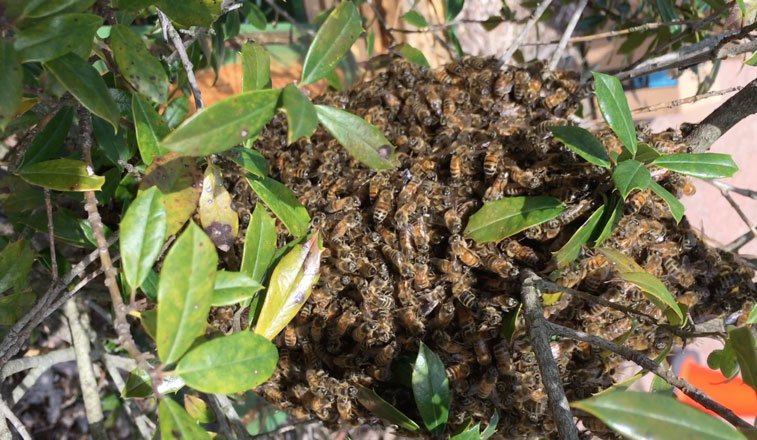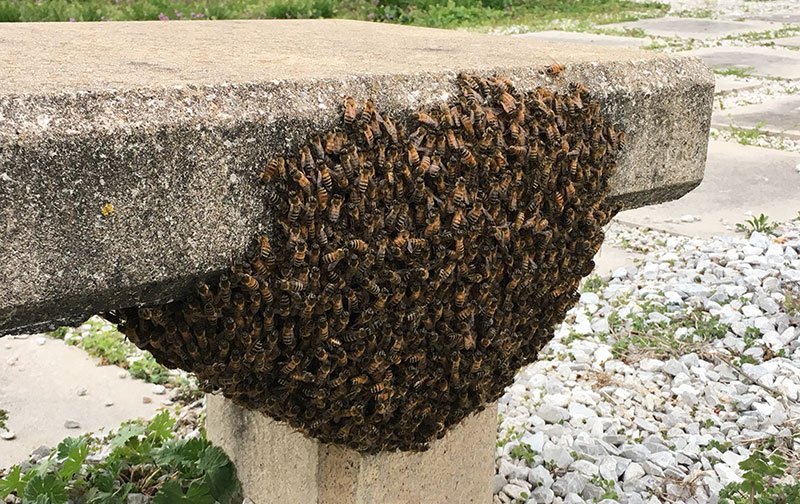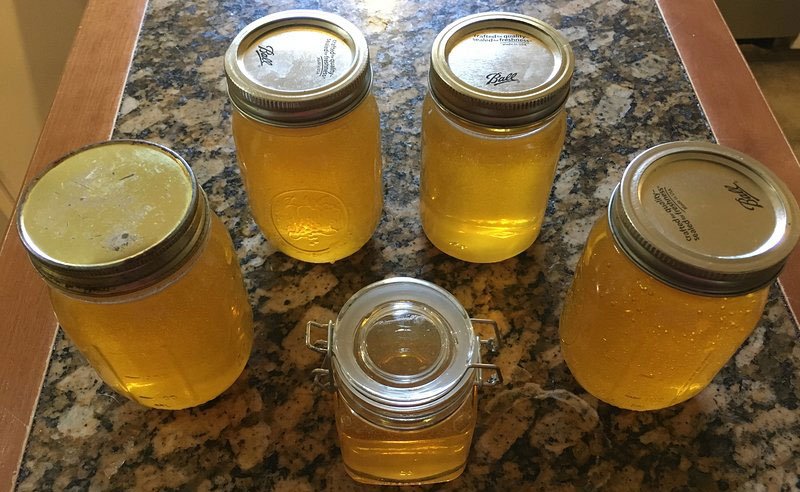Bees provide educational opportunities as well as honey
For all the years I have been the head Groundskeeper at Drury University there has been a honeybee hive in one hollow Mulberry tree in a section of our campus called College Park. The tree happens to be right along a main sidewalk, one that is used by essentially all the 200 or so students that live in those dorms. Several times over the years, the Facilities Department has fielded calls about the bees being a nuisance, or even a safety concern. However, once we have educated the caller, they usually are accepting of staying a little farther from the tree, and once again the beehive becomes inconspicuous.
Bee Coexistence
Any Groundskeeper knows that honeybees are about as harmless as any insect can be. Drury University has added hundreds/thousands of native trees, shrubs and flowers over the last 6 years. Despite this density of bee-friendly plants, I can’t think of the last time any of the grounds crew was stung by a bee, and we are constantly IN the plants. The one adjustment we configured on the “Bee Tree” was to cover the original entry point with heavy mesh and drill a hole higher up in the hollow. This arrangement has suited the bees fine. Their entry/exit is about 10’ off the ground. Most of their traffic is now high above the walkway. Drury Grounds also uses its social media to share info about Bees (pollinators in general) and educate people about their benefits plus how to be safe around them.
Honeybees are harmless and generally do not sting unless provoked.
Entering a New Phase
I have always thought about having a functional bee hive on campus, but it never seemed to gain traction. There are so many projects and tasks that are higher priority which meant that beekeeping was low on the list of priorities. That changed about a year ago when Drury’s newest Groundskeeper came to the job as a real-world beekeeper in his own time. Groundsman Leroy has about 10 hives at his house and is able to harvest and sell some delicious honey. Finally, his knowledge, the will of our Grounds Crew, and a donation of bee boxes from a faculty member (DU economist Steve Mullins) came together this spring.
Capturing a Swarm
Obtaining bees is not easy. Apparently native bees, caught naturally, are more durable and are more likely to be successful as a hive. This is because they have proven tough and adaptable in the environments they live in. Bees are also available for purchase, but our fledgling effort did not have funding. Therefore, we set out to capture a swarm. This April, the Bee Tree split a swarm. We were able to catch the basketball size ball o’ bees and tried several times to settle them into our bee box. Initially, the queen left the hive and settled nearby. It was only later that evening that we found the box empty and the bee-basketball under a nearby bench. Before sunrise the next morning we recaptured the swarm (AND the queen). This time we sealed the hive for 24 hours and used old frames with wax residue on them. Apparently, this helped make the bees feel more inclined to make this box their new home.


Quite a Success Story
The Drury beehive is a little over 2 months old now. In early July we opened the hive to assess its status and see how things were progressing. We found a healthy, vibrant colony that was doing just what we (and they) wanted. The Queen was laying eggs and filling frames with brood. Some of the brood frames had an arch of honey over them which is exactly what we want to see. The honey super was almost full too. In fact, the honey storage was going so well, we could harvest our first 3 frames of honey. The full frames were replaced with empty ones which will spur the bees to get busy again. The afore-mentioned Dr. Mullins has recently donated another brood box and honey super which we plan to install soon.

Plans for the Future
Our goal for the bee program at Drury University is still being developed. For us on the Grounds Crew our plan is to build the size of this colony this year, and hopefully have enough of a population that we can split the colony next spring. Of course, if the colony naturally sends out a swarm, we will be prepared and hopefully catch it to add to our program. Grounds will also be watching the “bee tree” to see if it will swarm again also. We also plan on having several capture boxes placed around campus in the hope we will catch a random swarm from nearby. Drury Administration has signed off on the bee program and has given preliminary approval to Drury pursuing “Bee Campus” certification. This program is sponsored by BeeCityUSA organization. The BEE Campus program seeks partner universities to raise awareness of pollinators, enhance habitat, and share success stories.
Drury is “Bee”-eautiful
Drury University has been pushing habitat improvement for several years to increase species diversity (birds, plants, insects, etc.) and improve the ecologic services our campus can provide (stormwater management, carbon sequestration, air quality improvement, soil protection, etc.). We have pursed these goals through diversification of the planting regime, repopulating the urban forest, managing water use, and decreasing chemical interventions. Our efforts have resulted in improved habitat for a range of organisms both small and large. The humble honeybee is just one of many organisms that are thriving on our campus. Creating a campus that is appealing to bees will ensure that Drury will be appealing to our human visitors as well. Hopefully Drury will be a “sweet” destination also.


0 Comments
Recommended Comments
There are no comments to display.